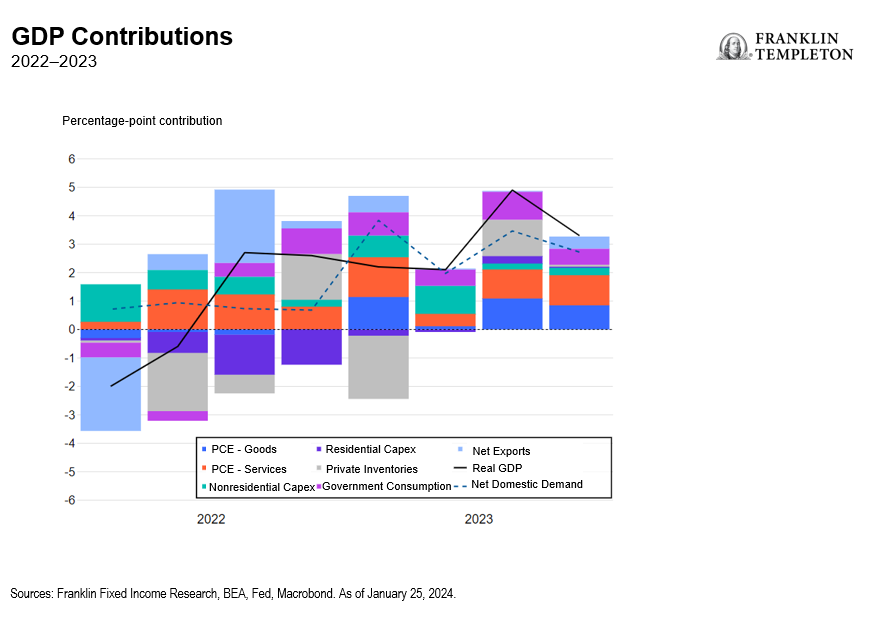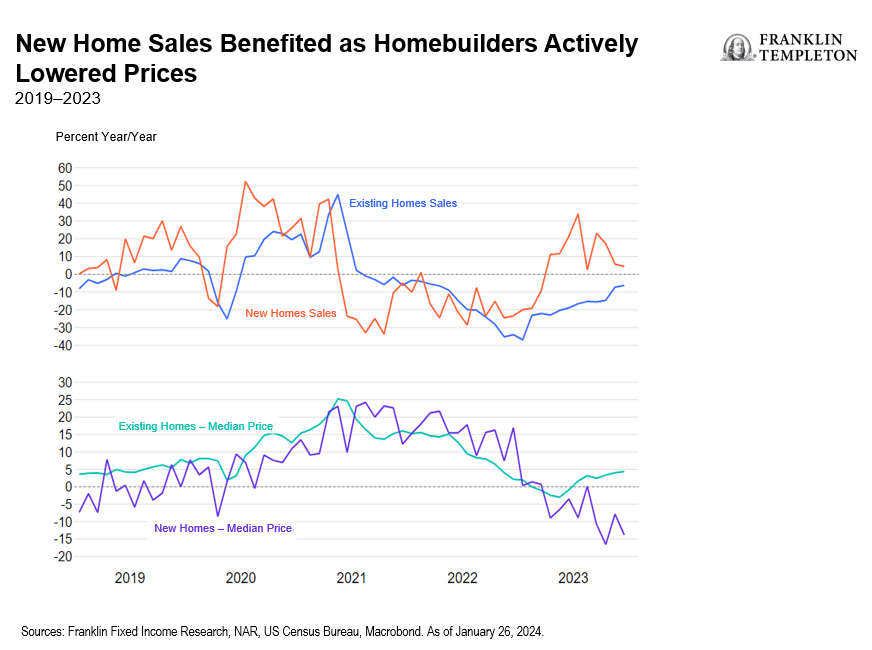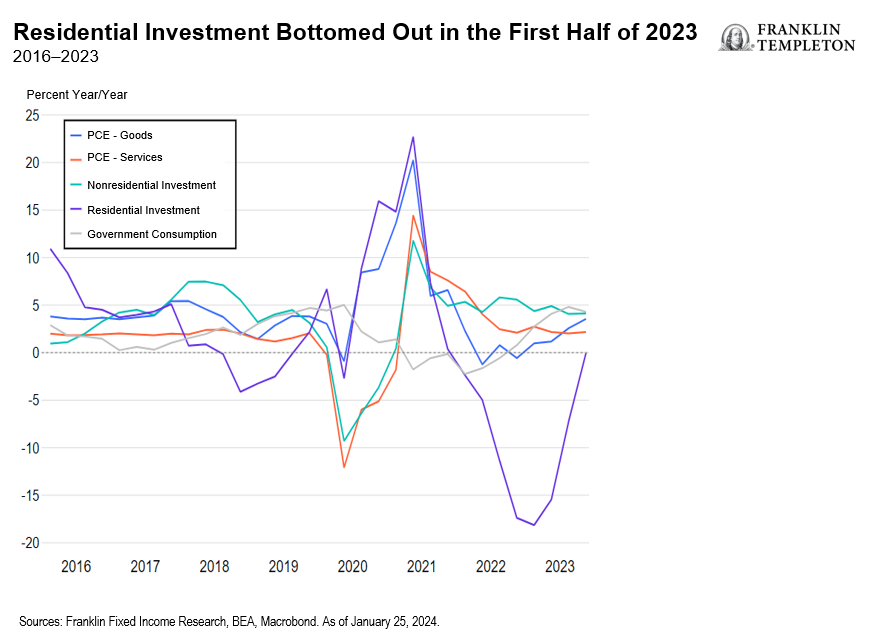by Nikhil Mohan, Economist, Franklin Fixed Income, Franklin Templeton
US gross domestic product surprised to the upside in the fourth quarter of 2023, primarily led by US consumers and the government. Franklin Fixed Income Economist Nikhil Mohan sees the growth mix remaining largely the same in 2024.
US gross domestic product (GDP) surprised to the upside in the fourth quarter of 2023, growing 3.3% on a quarterly annualized basis—well above our expectations (2.1%) as well as consensus expectations (2.0%).1 Some of the upside surprise was likely due to the lower-than-anticipated price deflator growth (1.5% actual vs. 2.2% expected) and the positive contribution from net exports.2 However, it was the consumer and government consumption that continued to do much of the heavy lifting, with the two alone contributing 2.6 percentage points (pp) to headline GDP. Growth and contributions from both residential and non-residential investment remained muted.
We expect the growth mix to remain broadly similar going forward, with the consumer and the government (especially given it’s an election year) likely to power growth in 2024 as well. While inflation has slowed notably (the Core Personal Consumption Expenditure [PCE] deflator is already at 2% on a quarterly annualized basis), the labor market and wages haven’t softened quite as swiftly.3 Therefore, real incomes should remain supportive of household consumption. Likewise, the positive wealth effect from the increase in valuations for real estate and equities over the past 2-3 quarters should also be a net positive for consumption. Moreover, as inflation has receded, consumer sentiment has risen, as indicated by both the University of Michigan and Conference Board surveys. We believe that positive outlook from households should keep the economy on track for further expansion, even if other drivers of growth remain lackluster.
Although business investment slowed markedly on a sequential basis in the second half of 2023, it still ended up 4.1% higher on a year-over-year (y/y) basis, which puts it right in line with the 2015-2019 average, and this is despite a significantly higher interest-rate environment. However, looking ahead, business investment may remain muted given the uncertainty ahead of elections in November, along with rising concerns about weaker global growth.
As for residential investment—there already appear to be some green shoots in the form of rising new home sales, building permits and housing starts, while existing home sales have turned less negative (all on a y/y basis). Moreover, with mortgage rates down over a 100 basis points since late October, mortgage applications have started to turn up again (albeit from very low levels). While lower borrowing costs should support residential investment (particularly in the second half of 2024), a tight housing market has meant that existing home prices have continued rising through much of 2023—up over 4% y/y.4 However, new home prices have bucked this trend as homebuilders tried to offset the high rates environment by actively lowering prices through 2023—down almost 14% y/y—which in turn aided sales.5 However, new homes account for roughly 14%-15% of total home sales.6 Therefore, the lack of affordable housing will likely continue to offset some of the positives even as borrowing costs edge lower.
*****
WHAT ARE THE RISKS?
All investments involve risks, including possible loss of principal.
Fixed income securities involve interest rate, credit, inflation and reinvestment risks, and possible loss of principal. As interest rates rise, the value of fixed income securities falls. Low-rated, high-yield bonds are subject to greater price volatility, illiquidity and possibility of default.
IMPORTANT LEGAL INFORMATION
This material is intended to be of general interest only and should not be construed as individual investment advice or a recommendation or solicitation to buy, sell or hold any security or to adopt any investment strategy. It does not constitute legal or tax advice. This material may not be reproduced, distributed or published without prior written permission from Franklin Templeton.
The views expressed are those of the investment manager and the comments, opinions and analyses are rendered as at publication date and may change without notice. The underlying assumptions and these views are subject to change based on market and other conditions and may differ from other portfolio managers or of the firm as a whole. The information provided in this material is not intended as a complete analysis of every material fact regarding any country, region or market. There is no assurance that any prediction, projection or forecast on the economy, stock market, bond market or the economic trends of the markets will be realized. The value of investments and the income from them can go down as well as up and you may not get back the full amount that you invested. Past performance is not necessarily indicative nor a guarantee of future performance. All investments involve risks, including possible loss of principal.
Any research and analysis contained in this material has been procured by Franklin Templeton for its own purposes and may be acted upon in that connection and, as such, is provided to you incidentally. Data from third party sources may have been used in the preparation of this material and Franklin Templeton (“FT”) has not independently verified, validated or audited such data. Although information has been obtained from sources that Franklin Templeton believes to be reliable, no guarantee can be given as to its accuracy and such information may be incomplete or condensed and may be subject to change at any time without notice. The mention of any individual securities should neither constitute nor be construed as a recommendation to purchase, hold or sell any securities, and the information provided regarding such individual securities (if any) is not a sufficient basis upon which to make an investment decision. FT accepts no liability whatsoever for any loss arising from use of this information and reliance upon the comments, opinions and analyses in the material is at the sole discretion of the user.
Products, services and information may not be available in all jurisdictions and are offered outside the U.S. by other FT affiliates and/or their distributors as local laws and regulation permits. Please consult your own financial professional or Franklin Templeton institutional contact for further information on availability of products and services in your jurisdiction.
Please visit www.franklinresources.com to be directed to your local Franklin Templeton website.
____________
1. Sources: Bureau of Economic Analysis, Franklin Fixed Income, Bloomberg. As of January 25, 2024.
2. Sources: Bureau of Economic Analysis, Franklin Fixed Income, Bloomberg. As of January 25, 2024.
3. Source: Bureau of Economic Analysis. As of January 25, 2024.
4. Source: S&P CoreLogic Case-Shiller Home Price Index. As of January 25, 2024.
5. Source: US Census. As of January 25, 2024.
6. Source: US Census. As of January 25, 2024.

















